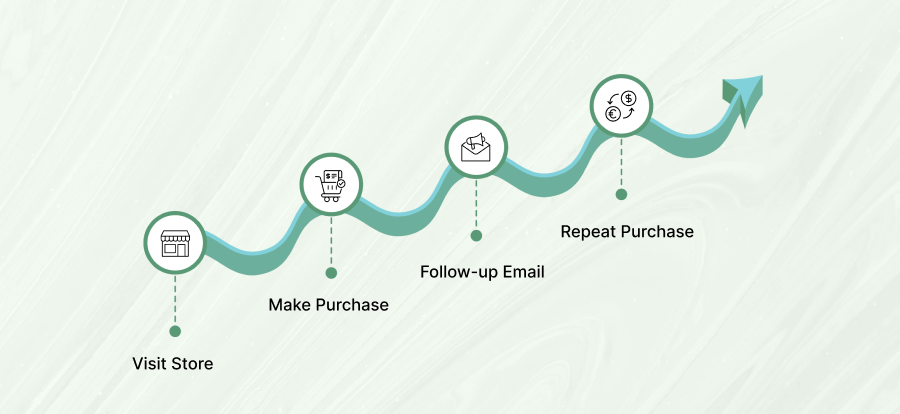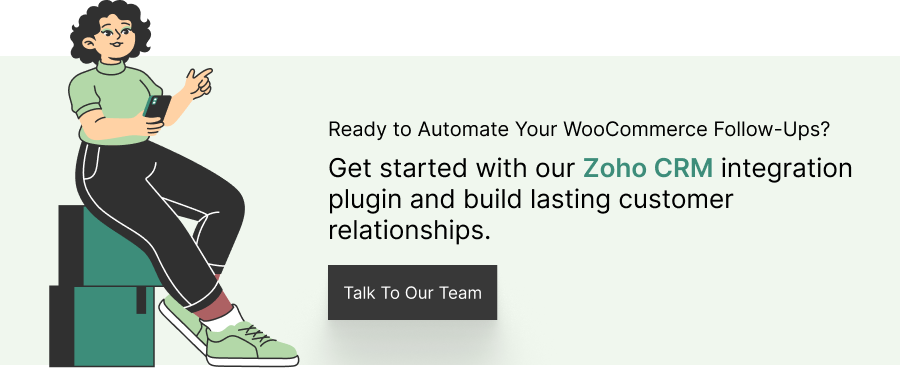
A customer lands on your WooCommerce store, finds something they like, adds it to their cart, and checks out. And that’s it. The sale is done. But is your job really over?
Not even close.
Because what happens next can either build a relationship or leave your customer forgetting your brand entirely.
Think about the last time you bought something online. Did the brand follow up? Did they thank you? Recommend something helpful? Remind you about an abandoned cart or send a loyalty reward?
If they did, chances are you remembered them. Maybe even went back.
This is exactly where customer follow-ups make all the difference and why smart eCommerce brands are automating them.
In this blog, we’ll show you how to set up effortless, personalized, and perfectly timed follow-ups using WooCommerce and Zoho CRM so you can keep customers engaged after the sale without spending your day buried in spreadsheets or copy-pasting emails.
Let’s turn your store into the kind customers come back to.

Most online stores focus heavily on getting the first sale. But real growth happens after that. Following up with your customers is one of the simplest ways to build trust, increase return visits, and boost long-term revenue. The challenge is doing it consistently without eating up hours of your day.
That’s where automation steps in.
Reduces manual workload
Automating follow-ups removes the need for constant check-ins, manual emails, or juggling spreadsheets. It frees up your time so you can focus on running your store, not chasing after each customer interaction.
Increases customer satisfaction and engagement
Customers appreciate timely updates, personalized messages, and thoughtful reminders. When follow-ups are automated, you ensure every customer feels seen and supported without missing a beat.
Boosts repeat purchases and lifetime value
A one-time purchase is good. A returning customer is better. Follow-up emails and offers can turn a single transaction into a long-term relationship, increasing your average customer lifetime value over time.
Enables timely communication
Order confirmations, shipping updates, abandoned cart reminders, or product restock alerts. When these messages are sent automatically, they arrive exactly when customers need them. That timing builds trust and improves the overall shopping experience.
Automation isn’t just about saving time. It’s about creating a consistent and thoughtful experience that keeps your customers coming back.
When your WooCommerce store and Zoho CRM work together, you’re not just collecting data. You’re creating a connected system that helps you understand your customers, personalize their experience, and follow up at exactly the right time.
Here’s how this integration brings everything together.
Real-time and batch data syncing
Orders, contacts, products, and customer interactions are synced smoothly between WooCommerce and Zoho CRM. Whether it’s a single order or hundreds of records, your data stays up to date without manual effort.
Custom mapping of user roles, coupons, and order history
You can map important WooCommerce data to Zoho CRM exactly how you want it. This includes customer roles, past purchases, and even coupon usage. That flexibility means you’re not stuck with a one-size-fits-all system.
Two-way sync keeps your CRM and store aligned
If stock levels change in WooCommerce or updates happen in Zoho CRM, both systems reflect those changes. This two-way sync helps prevent errors, duplicate work, or outdated information that could confuse your team or your customers.
Automatic sync of browser and IP information
Every customer interaction carries context. By syncing browser details and IP addresses, you gain deeper insights into your users’ behavior and preferences. That kind of data can make your follow-ups smarter and more targeted.
Integrating WooCommerce with Zoho CRM doesn’t just help you stay organized. It gives you the foundation for smart, automated customer engagement built on clean, real-time data.
If you’re wondering how the automation really happens behind the scenes, it’s all thanks to a few smart features built into the WooCommerce and Zoho CRM integration. These tools do the work of collecting customer info, understanding what they did on your site, and triggering the right follow-up without you lifting a finger.
Here’s how it all comes together.
Follow-ups based on customer actions
Let’s say someone places an order or abandons their cart. That action can instantly trigger a follow-up from Zoho CRM. It could be a thank-you email, a reminder to complete the checkout, or even a product suggestion.
Cart abandonment tracking that doesn’t miss a lead
Both guest users and logged-in shoppers are tracked if they leave something in their cart. This info gets sent to Zoho CRM so you can follow up with a friendly nudge or offer to bring them back.
Know who used a discount and follow up smarter
When someone uses a coupon, that data is synced too. You can then send tailored messages like “Your favorite product is back on sale” or “Here’s another offer just for you.”
Use order notes and user roles to personalize messages
If a customer leaves a message during checkout, it’s stored and synced. This lets you send more thoughtful responses. You can also group users like subscribers or members and send follow-ups that speak directly to their status.
Understand user behavior behind the scenes
The plugin even tracks basic browser and location data. It’s not just technical info. It helps you understand when and how people are shopping so your follow-ups can be better timed and more relevant.
Together, these features make your follow-up strategy feel personal and well-timed without you having to manage it all yourself.

Getting started with WooCommerce and Zoho CRM integration doesn’t require any technical background. Once set up, the system runs quietly in the background, helping you automate customer follow-ups without extra effort.
Here’s a simple step-by-step guide to get things going.
Step 1: Install and connect the plugin
Start by installing the WooCommerce Zoho CRM integration plugin on your WordPress site. Once it’s active, connect it to your Zoho CRM account using your API credentials. This creates a secure connection between your store and your CRM.
Step 2: Map your data fields
Next, map your WooCommerce data to Zoho CRM fields. This means linking customer names, emails, order values, and other key details from your store to the right places in your CRM. It ensures that the right information ends up in the right spot.
Step 3: Set up your feeds
Feeds tell the system what kind of data to sync and where to send it. For example, you can create a feed that sends new orders to the “Deals” module in Zoho, or one that adds new customers to your “Contacts.” You can also create custom feeds based on your specific needs.
Step 4: Create automation rules inside Zoho CRM
This is where the follow-up magic happens. Use Zoho’s workflow builder to trigger actions based on the data synced from WooCommerce. For example, you can set it to automatically send a thank-you email three days after a customer places an order, or assign a sales rep when a deal value crosses a certain amount.
Once you’ve followed these steps, your follow-up system runs on its own. Your WooCommerce store and Zoho CRM stay in sync, and your customers stay connected.
The sale might be complete, but your job as a store owner isn’t over. What happens after the purchase is just as important as what led up to it. When you follow up at the right time with the right message, you stay in your customer’s mind and build long-term trust.
By connecting WooCommerce with Zoho CRM, you can automate these follow-ups without adding extra work to your plate. It keeps your store running smoothly and your customers feeling valued.
Start small, keep it consistent, and let the automation do the heavy lifting. Your future repeat customers will thank you for it.
Have questions or need help setting it up? Contact us — we’re here to help.